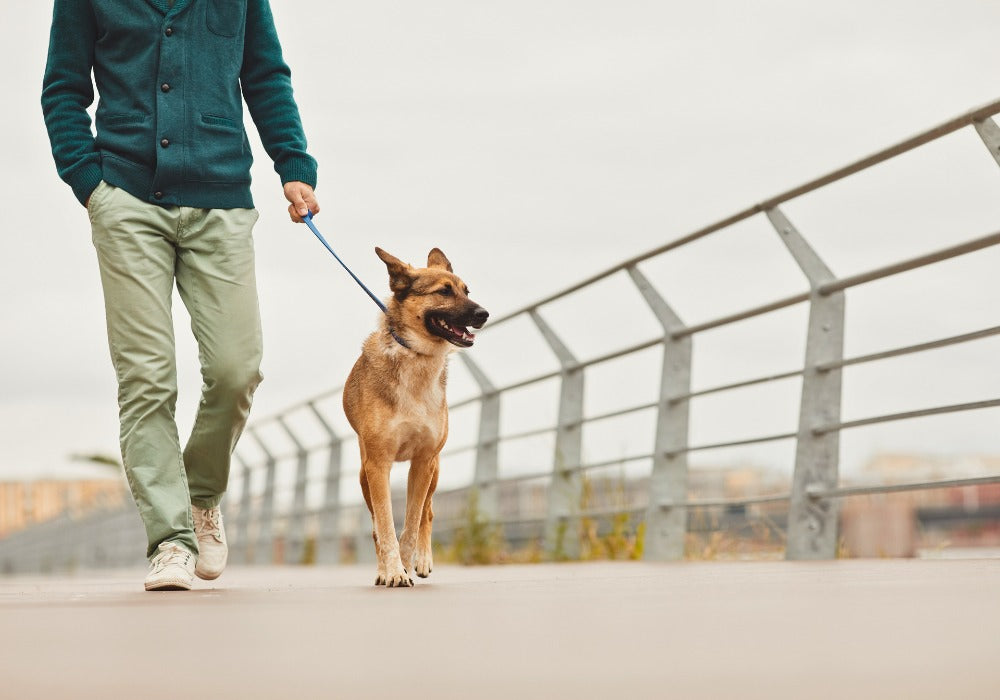Training Your Dog at Home vs. in Public: A Complete Guide

This article was updated on November 25, 2024.
Imagine your dog as a young child starting school. They need to learn the basics, like how to sit, stay, and come when called. This is where home training comes in. It's like a cozy classroom where your dog can focus on learning without distractions.
Now, picture your furry friend stepping out into the world, facing new people, noises, and scents. This is like public training. It's where your dog learns to behave well in real-life situations, even when things are a bit chaotic.
Both home and public training are important for your dog's overall development. Home training gives them a solid foundation, while public training helps them adapt to the real world.
Dog Training at Home
Training in your home provides a familiar and controlled setting for your dog. It’s a safe space where they can relax and focus on learning.

Here are some tips for creating a comfortable training environment at home:
1. Choose a quiet area.
Avoid training in busy or noisy areas of your home, such as the kitchen or living room. Instead, opt for a quieter space like a bedroom or hallway.
2. Minimize distractions.
Turn off the TV, put away toys, and ask family members to be quiet during training sessions.
3. Use positive reinforcement.
Reward your dog with high-value treats, praise, or petting when they obey your commands. This will create a positive association with training and make them more eager to learn.
4. Keep training sessions short and fun.
Aim for 10-15 minutes for every training session. This will make your dog stay engaged and prevent boredom or frustration.
Laying the Foundation
Home training is where your dog learns the fundamental commands that will serve them well throughout their life. These foundational commands include:
-
Sit
Hold a treat above your dog's nose and slowly move it over their head. This will prompt them to sit down. Once they're in a sitting position, say, "Sit," and give them the treat. Repeat this process until they consistently associate the "sit" command with the action of sitting.

-
Stay
With your dog sitting, hold out your palm and say, "Stay." Then, take a few steps back. If they stay in place, reward them with a treat. Gradually extend the distance and duration of the exercise as they progress.

-
Come
Start with your dog a short distance away and call their name. When they come to you, give them a treat and praise them. Repeat this process, gradually increasing the distance.

With your dog on a leash, hold it on your side and walk at a steady pace. Say "heel" and encourage them to walk alongside you. If they stray from your side, gently guide them back into position. Reward them with treats as they walk correctly.

Challenges in Home Dog Training
While home training offers a convenient setting for teaching your dog basic commands, it also presents certain challenges. These include:
- Limited Exposure to Distractions
Training in a familiar environment can make it difficult for dogs to generalize their learned behaviors to public settings. They may not obey commands reliably when faced with distractions like other dogs, people, or loud noises.

- Leash Reactivity
Dogs may exhibit leash reactivity, such as leash pulling or barking. This behavior is often more pronounced in public places, where more stimuli can trigger their reactions.

To address these challenges, incorporate public training into your dog's overall training plan.
Dog Training in Public Spaces
Public spaces serve as a practical training ground, simulating real-world scenarios that your dog might encounter. These environments offer a dynamic setting where your dog can practice obedience amidst the hustle and bustle of everyday life.

Essential Items for Your Dog's Public Training Kit
Before heading out for public training, prepare a well-stocked training kit to ensure you have everything you need. Here are the essential items to include:
- Leash and collar: Choose a comfortable and secure leash and collar that suits your dog's size and temperament. A sturdy leash will provide control, while a comfortable collar won't cause discomfort or chafing.
- Treats: Bring your dog’s favorite treats that motivate them to follow commands and perform desired behaviors.
- Training pouch or bag: Invest in a training pouch or bag to conveniently carry all your essential training items.
- Clicker (optional): If you use clicker training, include a clicker in your training kit. The clicker's distinct sound marks precise moments of obedience, helping your dog make clear connections between actions and rewards.
- Water: Always carry water and a collapsible bowl to keep your dog hydrated during training sessions, especially in warmer weather.

How to Train Your Dog in Public
Here's a step-by-step guide on how to train your dog in public:
1. Start in low-traffic areas.
Introduce your dog to public environments with minimal distractions to ease them into the experience. Opt for quiet parks, empty parking lots, or early morning walks in tranquil neighborhoods. These low-traffic settings allow your dog to acclimate to the sights, sounds, and smells without feeling overwhelmed. Use a leash to maintain control and prevent your dog from running off.

2. Focus on basic obedience commands.
While in low-traffic areas, focus on practicing basic dog commands, such as sit, come, and heel. Incorporate positive reinforcement techniques to reward your dog for following your commands. You can use a clicker to mark the moment of correct behavior.

3. Gradually increase exposure.
As your dog becomes more comfortable in low-traffic areas, gradually increase their exposure to more stimulating environments. Venture into busier parks, explore pedestrian-friendly streets, or visit pet-friendly establishments during off-peak hours. Start with brief exposures and gradually extend the duration as your dog's confidence grows.
- Busier parks: Start by visiting busier parks during off-peak hours, such as early mornings or late evenings. Choose parks with designated dog areas and observe how your dog interacts with other dogs and people. Keep your dog on a leash at all times.
- Pedestrian-friendly streets: Explore quieter pedestrian-friendly streets, avoiding busy sidewalks and crowded areas. Walk your dog on a loose leash while maintaining control and rewarding them for staying by your side. Introduce distractions gradually, such as passing cars or people walking by.
- Pet-friendly establishments: Visit pet-friendly establishments during off-peak hours, such as pet stores or coffee shops with outdoor patios.

4. Keep training sessions short and positive.
Aim for short, focused training sessions to maintain your dog's engagement. End each session on a positive note to leave them feeling confident and happy.

5. Observe and adapt.
Pay close attention to your dog's body language and reactions throughout the training process. If they exhibit signs of discomfort, anxiety, or fear, take a step back and move to a less stimulating environment. Avoid pushing your dog beyond their comfort zone, as this can lead to negative associations.
Public Dog Training Hurdles
Public environments pose specific challenges for dog training, often due to:
-
Distractions and Overstimulation
-
Fear and Reactivity
Is an E-Collar a Good Way to Train a Dog?
E-collars, or electronic collars, can be a helpful tool for training dogs, offering a unique blend of communication, control, and safety. They provide a means to bridge the distance between the handler and dog, enabling effective training even in challenging environments.

Top 3 Reasons for E Collar Dog Training
1. Clear and Precise Communication
Dog training e-collars deliver immediate feedback at the precise moment a dog exhibits unwanted behavior. This timely intervention allows for more effective corrections, as the dog can clearly associate the feedback with the undesired action. This can be especially useful when physical contact is limited, such as managing behaviors in public settings.
2. Remote Control
E-collars can be particularly helpful for training dogs with strong prey drives or those who tend to run off when off-leash. The remote stimulation can provide a deterrent or recall cue, keeping your dog safe and under control.
3. Safety
E collars can play a crucial role in ensuring dog safety in public places, particularly in situations where potential hazards may arise. They provide immediate and remote control, which can reduce the risk of accidents or injuries.
PetsTEK’s Picks: Best E Collars for Dogs
1. Dogtra 1900S Black Boost & Lock Remote Training Collar

Features:
- 1-Mile Range
- Boost & Lock Feature
- Premium Matte Black Finish
- 127 Levels of Static Stimulation
- High-Performance Non-Stimulation Pager Vibration
- Low to High Power Output
- 1-Dog Model
- For Dogs as Small as 35 Pounds
The Dogtra 1900S Black Boost & Lock is a sleek dog training collar with a premium matte black finish. It has the longest range among the Boost & Lock series, with an impressive reach of up to 1 mile. This shock collar is a must-have training tool for medium to large dogs.
2. Dogtra 1900S Handsfree Plus Boost & Lock Remote Training Collar

Features:
- 3/4-Mile Range
- Boost & Lock Option
- HANDSFREE SQUARE with Bluetooth Technology
- Expandable up to 14 HANDSFREE SQUARES
- 127 Levels of Static Stimulation
- High-Performance Pager Vibration
- Low to High Power Stimulation
- 1-Dog Unit
- For Dogs 35 Pounds and Up
The Dogtra 1900S Handsfree Plus Boost & Lock is an innovative training device that combines the classic 1900S e-collar with a compact, hands-free SQUARE. The expandable SQUARES allow multiple users to control the collar, making it ideal for trainers or families training with multiple dogs. This e collar also features a Boost & Safety Level Lock function for added safety and control.
3. Mini Educator ET-300 Remote Training Collar by E-Collar Technologies

Features:
- ½-Mile Range
- 1-100 User-Selectable Levels of Wide Pulse Stimulation
- 1-60 Levels Additional Boost
- Pavlovian Tone and Non-Stimulating Vibration
- Lock and Set Technology
- Ergonomic “Stopwatch” Transmitter
- Expandable to 2-Dog System
- For Dogs 8 Pounds and Larger
The Mini Educator ET-300 is a popular choice among dog owners and trainers. This Educator collar has three color options: yellow, black, and Educator Zen 300. It has 100 levels of static stimulation, Pavlovian tone, and vibration. It also offers a custom boost with up to 60 levels.
4. Dogtra 2700T&B Expandable Remote Dog Training Collar

Features:
- 1-Mile Range
- 127 Levels of Static Stimulation
- Rheostat Dial
- Adjustable Beeper Tone
- LCD Screen
- Fully Waterproof
- For Dogs 35 Pounds and Up
The Dogtra 2700T&B Expandable is the perfect shock collar for your outdoor adventures. It has a 1-mile range, 127 stimulation levels, and 3 beeper modes for easy tracking of your dog. This remote collar is available in a limited edition all-orange set for enhanced visibility.
5. Dogtra 1900S Wetlands Boost & Lock Remote Training Collar

Features:
- 3/4-Mile Range
- Boost & Lock Function
- 1-Dog Model
- 127 Levels of Static Stimulation
- Nick and Constant Static Stimulation
- High-Performance Non-Stimulation Pager Vibration
- Fully Waterproof
- For Dogs as Small as 35 Pounds
The Dogtra 1900S Wetlands Boost & Lock is the perfect hunting collar for dogs. It features a camouflage-patterned receiver and collar strap that blends in with the environment. This waterproof system is suitable for all weather conditions, making it ideal for hunting or training in any season. With a range of 3/4 mile and a Boost & Lock feature, this e-collar provides versatility and dependability even for complicated training sessions.
You might also enjoy...
-
Posted in
Dog Training, Remote Training Collar, Training Tips


